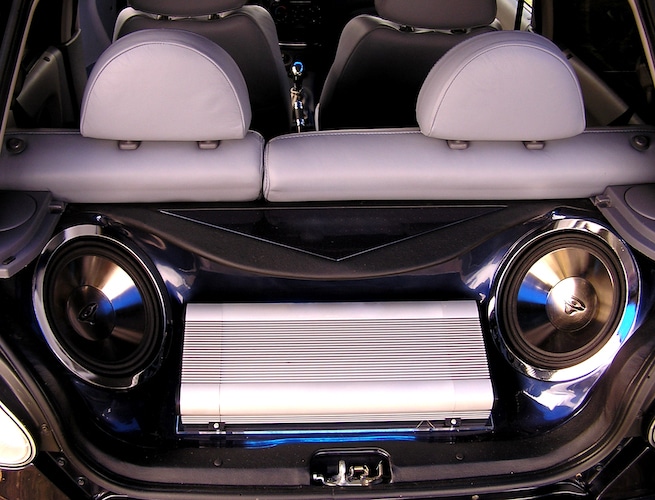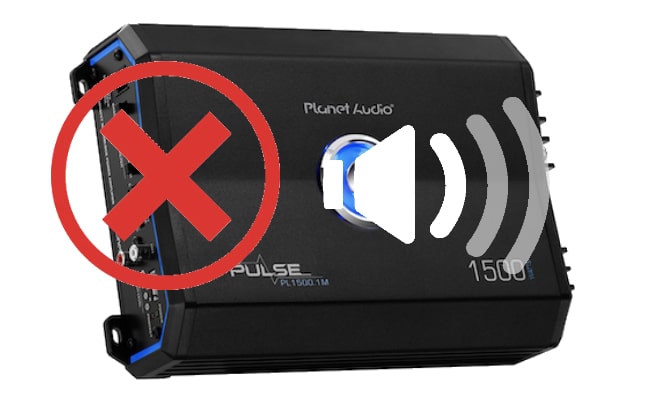7 Repair Tips When You Get An Amplifier Low Volume Problem
Have you recently purchased a new amp and finally installed it in your car? You’d expect clear, crisp, and better sound, right?
Oftentimes, amps wear down over time, resulting in an unpleasant sound experience and audio quality. That’s a common problem. But other times, there’s a solution to that problem.
Lucky for you because it does not take a huge amount o effort or knowledge to assess a faulty amplifier.
In this guide, we will take the time to help you fix the amplifier low volume problem and provide you with the best possible solution.
Repairing Tips on How to Troubleshoot Low Volume Problem of Your Amplifier?

#1 Receiver volume level and gain control adjustments
Turn everything off. Unplug the RCA cables component connected to the amp and turn the stereo back on. Without music playing, turn up the volume on the head unit all the way up. Remember the number shown on the receiver.
After knowing the system’s maximum volume, dial it back down to 80% and set the Equalizer Settings of your stereo to Flat. Now, set the Gain and Bass Boost to zero and set your crossover filters to off/full.
Plug back all the RCA cables into the speaker channels you like to tune. Play music on the radio and slowly raise the gain setting until you notice a distortion coming from the connected speakers.
Slowly minimize the gain until you don’t hear it buzzing out. That will be the base gain setting you’ll utilize to tun the different frequencies.
#2 Tune individual frequencies
Switch the crossovers and filters back on. If you are tuning your sub-woofers, pick the LPF (low-pass filters) and utilize the HPF (high-pass filter) for the other speakers.
Are you currently using mid-sized speakers to cover the frequencies? You can ignore this step and leave the filters and crossovers in the off or full position.
Are you tuning your sub-woofers? Test the maximum rating of the subwoofer and set the frequency dial to a similar number.
Meanwhile, if you are tuning on the rest of the speaker system, you can determine their lowest frequency rating and set the setting to that number.
#3 Bring the bass signal level up
Are you the kind of person who loves chest-thumping, window-rattling bass coming from your vehicle’s sound system? You must raise the bass boost setting of your car’s amp. Remember that this can be challenging and will put a lot of pressure on your subwoofer.
To increase your bass boost, you must set the gain down. Adjust those two settings simultaneously. Your job is to get the highest bass amount without getting any distortion. That might take a little while, as you’ll be adjusting two settings at the same time.
#4 Tweak the gain or volume level
After you set up the bass boost and speaker frequencies, you can go back to set the gain. Turn on the radio and set its volume back to eighty percent of the maximum.
Turn the gain up slowly until you notice any distortion coming from the speakers. Slowly dial down the settings until the distortion vanishes.
#5 Fine-tune the internal speakers
Connect the amplifiers again and turn the low volume of your stereo all the way down to zero. Now, slowly turn up the low volume until you reach the eighty percent mark or until you hear any distortion.
If you’ve turned everything properly, you will certainly hit the eighty percent volume without hearing distortion.
Meanwhile, if you hear any distortion, determine which of the speakers are the causes and turn down their gain settings up until they are no longer distorted.
#6 Check the speaker wires
One of the common reasons why you may notice low volume is due to a faulty speaker wire. After checking the control knobs and the voltage on your amp, you must also check if the wires are securely connected. With time they tend to loosen up due to the vibrations.
#7 Verify the tube amp power supply connection
A tube amp uses vacuum tubes to boost the signal amplitude. If the power connection is not secure, it can introduce electrical noise and reduce the overall volume.
When these amps have a volume loss problem, the first thing you should do is check the power supply connection and make sure everything is plugged in properly.
The next thing you should do is to confirm that you don’t have a blown fuse. If the fuse is blown, you will need to replace it with a new one that can handle the same amount of current to get it completely fixed.
Why Are There No Sounds in My Car Amp?

If your amp turns on, ensure that it is getting audio signals from the input sources that are coming into the car stereo. That is a simple process, especially if you have access to both the tube amp and the A/V receiver.
Just unplug the RCA cables from every device and reconnect them with a good set. After confirming that the car radio and volume controls are turned on and up, cycle through the inputs (like the auxiliary, DVD player, CD player, or the tuner).
If everything works after you bypass the installed RCA cables, you can then change them with a good set. If you receive sound from one input source but not the other, the issue lies in the A/V receiver and not the power amp.
But if you still do not receive any output from the amp, you can disconnect it from your car’s speakers and hook it up to a known good speaker that is not your vehicle.
If your amp drives that, the issue is with the wiring or speakers. If you still do not get any sound, your tube amp might be malfunctioning.
Make sure it is not in the subordinate mode and that there are not any conflicting filters before you condemn the A/V receiver.
Why Does My Subwoofer Sound Like It Is Farting?
Odd sounds could come from a subwoofer that is underpowered, overpowered, or installed incorrectly. Thus, getting to the bottom of this issue can take some work.
First, make sure you get rid of the issues with the woofer enclosure. If your enclosure is not the proper fit for the sub, your sub will not sound right.
On top of that, an improperly mounted woofer could enable air to escape while you are listening to music. That’s because the vibrating speaker cone pushes air into and out of the box past the seal.
Also, seating the speaker correctly to prevent the resulting fart-like sounds. If there is nothing improper with your enclosure, ensure the woofer is impedance-matched. Take note that impedance matching is easy only if you have a sub attached to one amp—it matches, or it does not.
Do you have several subs attached to a single amp? You will need to perform some measurements according to whether they are properly connected in parallel or series.
If the impedance matches, ensure you check the power supply ratings of both the amp and the sub and make all the needed corrections, especially if the tube amp is underpowered or overpowered.
If you are only overpowering the sub, make sure you get a bigger subwoofer or do not overpower it.
How Do You Remove the Hissing and Other Distortion Sound in the Amp?
Check the speaker cables and patch cables. If the power cable connecting the amplifier and receiver runs alongside any power or ground cables at any point, it can pick up the interference that you will hear as distortion.
The same thing applies to the wires of the speakers. And the only solution is the following: reroute the wires so they don’t come close to any ground or power supply cables.
They should also cross at a 90-degree angle if needed. Using quality grounded wires or a cable with good shielding can help as well.
If you cannot find any concerns with the way the speaker wires or power cable is routed, you can unplug the internal speakers from the amp. If you still notice noises, check for bad ground. The issue might also be in your receiver or whatever else you utilize as an audio signal.
Why Does My Amp Sound Like It Is Clipping?
An underpowered amp or ineffective speakers are often the cause of clipping in a home audio speaker setup. Burnt or loose wires could introduce similar problems in vehicles.
Moreover, an underpowered amp is the cause of clipping, in which case, you will need either downgrade the speakers or upgrade the amp. Make sure you compare the power supply rating of the amp with the woofer.
If your amp has sufficient power for the application, the issue might be in your speakers, the wires, or the amplifier’s ground.
How Can I Disable the Protect Mode of My Amplifier?
Other amplifiers go into the protect mode to prevent further damage to internal parts. If the amp’s protect light is one, chances are you have a faulty cable, subwoofer, speaker, or another component.
Check for power as outlined above. Look at the individual components. Unplug the speaker cables. If the light turns off, the issue probably lies in one of the speakers.
Visually assess every subwoofer and speaker in your system. Also, a blown speaker could be the cause of the issue.
You can also use an ohmmeter to confirm that none of the speakers are grounded out. That can happen if wires become weak and in contact with the ground or when the speaker connections come in contact with bare metal.
If you cannot find any issues with the speakers, check the RCA patch cables. If you want to check that, hook up a set of RCA cables to the head unit and amp. If that causes your light to turn off, change the RCA cables.
FAQs
Q: How can you detect a blown amp fuse?
You can identify a blown amp fuse by replacing the fuse with the whole thing turned off. If the fuse blows, there is perhaps a short between that fuse and the rest of the system. You can change the fuse again with the amplifier connection.
However, if the fuse still blows, there’s a short somewhere within the wiring. If your fuse blows when the amplifier turns on, there’s perhaps an internal issue with the amp.
Q: How can you fix a damaged RCA jack on an amp?
To achieve max volume, your sound input source needs to provide a good audio signal as well. To resolve a damaged amp jack, you can disassemble the amp and utilize a soldering iron to reconnect the connector to the PBC board.
Q: Why does your stereo amp turn on and off by itself?
Is your car amp turning on and off by itself? Then it could be because of overheating or some amplifier wiring issues. Also, the car amp could be in Protect Mode.
Final Thoughts
Most of the time, amps that have only one channel are used to improve the bass quality of your sound system. So if you are experiencing a low sound problem, try upgrading your normal amp to a multichannel one to make the entire system louder.
Last Updated on: March 16, 2025

